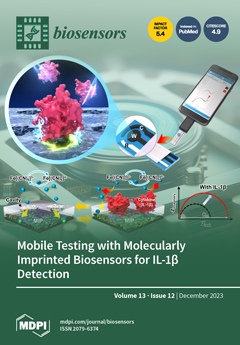The accurate and simultaneous detection of neurotransmitters, such as dopamine (DA) and epinephrine (EP), is of paramount importance in clinical diagnostic fields. Herein, we developed cerium–molybdenum disulfide nanoflowers (Ce-MoS
2 NFs) using a simple one-pot hydrothermal method and demonstrated that they are highly
[...] Read more.
The accurate and simultaneous detection of neurotransmitters, such as dopamine (DA) and epinephrine (EP), is of paramount importance in clinical diagnostic fields. Herein, we developed cerium–molybdenum disulfide nanoflowers (Ce-MoS
2 NFs) using a simple one-pot hydrothermal method and demonstrated that they are highly conductive and exhibit significant peroxidase-mimicking activity, which was applied for the simultaneous electrochemical detection of DA and EP. Ce-MoS
2 NFs showed a unique structure, comprising MoS
2 NFs with divalent Ce ions. This structural design imparted a significantly enlarged surface area of 220.5 m
2 g
−1 with abundant active sites as well as enhanced redox properties, facilitating electron transfer and peroxidase-like catalytic action compared with bare MoS
2 NFs without Ce incorporation. Based on these beneficial features, Ce-MoS
2 NFs were incorporated onto a screen-printed electrode (Ce-MoS
2 NFs/SPE), enabling the electrochemical detection of H
2O
2 based on their peroxidase-like activity. Ce-MoS
2 NFs/SPE biosensors also showed distinct electrocatalytic oxidation characteristics for DA and EP, consequently yielding the highly selective, sensitive, and simultaneous detection of target DA and EP. Dynamic linear ranges for both DA and EP were determined to be 0.05~100 μM, with detection limits (S/N = 3) of 28 nM and 44 nM, respectively. This study shows the potential of hierarchically structured Ce-incorporated MoS
2 NFs to enhance the detection performances of electrochemical biosensors, thus enabling extensive applications in healthcare, diagnostics, and environmental monitoring.
Full article






